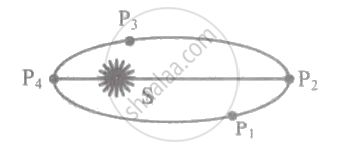Advertisements
Advertisements
प्रश्न
Give one example each of central force and non-central force.
उत्तर
Examples of central force:
- Gravitational force due to point mass.
- Electrostatic force on the point charge.
Examples of non-central force:
- The nuclear force depends upon the spin of particles.
- Magnetic systems act between two current carrying loops.
APPEARS IN
संबंधित प्रश्न
Let us assume that our galaxy consists of 2.5 × 1011 stars each of one solar mass. How long will a star at a distance of 50,000 ly from the galactic centre take to complete one revolution? Take the diameter of the Milky Way to be 105 ly
State Kepler's laws of planetary motion.
Answer the following question.
State Kepler’s law of equal areas.
Answer the following question in detail.
State Kepler’s three laws of planetary motion.
Observe the given figure showing the orbit of a planet moving around the Sun and write the three laws related to it:

The orbit of a planet moving around the Sun
A planet is revolving around the sun in an elliptical orbit as shown in figure. At which point will its K.E. be maximum?

Draw areal velocity versus time graph for mars.
Earth’s orbit is an ellipse with eccentricity 0.0167. Thus, earth’s distance from the sun and speed as it moves around the sun varies from day to day. This means that the length of the solar day is not constant through the year. Assume that earth’s spin axis is normal to its orbital plane and find out the length of the shortest and the longest day. A day should be taken from noon to noon. Does this explain variation of length of the day during the year?
lf the angular momentum of a planet of mass m, moving around the Sun in a circular orbit is L, about the center of the Sun, and its areal velocity is ______.
Halley's Comet revolves around the sun for a time period of 76 years. The aphelion distance if perihelion is given by 8.9 × 1010 m, will be ______.
(Take, the mass of sun = 2 × 1030 kg and G = 6.67 × 10-11 Nm3/kg2)
